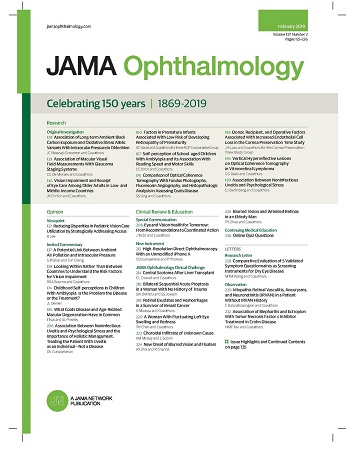脉络膜不确定黑素细胞瘤的恶性转化。
IF 7.8
1区 医学
Q1 OPHTHALMOLOGY
引用次数: 0
摘要
重要性:预测大脉络膜痣或不确定黑素细胞瘤(IMT)恶性转化风险的准确性尚不清楚。目的评估一组已知预后(观察状态;良性[大痣]或恶性[小黑色素瘤])。设计、环境和参与者:这是一项来自单一中心的患者队列研究。诊断为良性(大痣)或恶性(小黑色素瘤)的imt患者被纳入分析。这些病变分为大痣(良性;0%风险)在24个月或更长时间内有稳定记录。IMTs被归类为小黑色素瘤(恶性;100%风险)有定量生长或病理证实。数据分析时间为2024年10月至12月。大脉络膜痣或IMT恶性转化的预测。主要结局和测量主要结局包括预测模型、眼部黑色素瘤合作研究(COMS)和威尔斯眼科医院(WEH)模型的危险因素组合预测的5年Kaplan-Meier恶性转化概率。结果共123例患者,中位[IQR]年龄63[56-67]岁;89例男性(72%),62例大痣,61例小恶性黑色素瘤纳入本研究。COMS模型预测的5年黑色素瘤Kaplan-Meier概率均值为0.39 (95% CI, 0.32-0.46), WEH模型预测的5年黑色素瘤Kaplan-Meier概率均值为0.44 (95% CI, 0.39-0.49)。差异为-0.05 (95% CI, -0.14 ~ 0.04),无统计学意义。然而,COMS模型预测观察到的痣发生黑色素瘤的平均5年Kaplan-Meier概率为0.18 (95% CI, 0.12-0.23), WEH模型预测的平均5年Kaplan-Meier概率为0.31 (95% CI, 0.24-0.38)。差异为-0.13 (95% CI, -0.22 ~ -0.05),具有统计学意义。COMS模型和WEH模型的平均5年黑色素瘤Kaplan-Meier概率分别为0.21 (95% CI, 0.12-0.31)和0.13 (95% CI, 0.05-0.21)。利用约登指数确定COMS模型和WEH模型的最佳切割点分别为0.18和0.34。COMS模型的灵敏度低于WEH模型(-15.2%;95% CI, -25.6% ~ -4.8%), COMS模型的特异性高于WEH模型(差异11.7%;95% ci, 2.0%-21.4%)。结论和相关性本队列研究的结果表明,基于危险因素组合的2种不同模型预测的恶性转化风险不理想,可能导致约30%的患者过度治疗。这些发现支持寻求在临床实践中应用之前应该验证的其他预测方法。本文章由计算机程序翻译,如有差异,请以英文原文为准。
Malignant Transformation of Choroidal Indeterminate Melanocytic Tumors.
Importance
The accuracy of the predicted risk of malignant transformation of a large choroidal nevus or indeterminate melanocytic tumor (IMT) is not known.
Objective
To estimate the risk of malignant transformation (predicted risk) in a cohort of patients with IMT of known outcomes (observed status; benign [large nevus] or malignant [small melanoma]).
Design, Setting, and Participants
This was a cohort study of patients from a single center. Patients diagnosed with IMTs that were benign (large nevus) or malignant (small melanoma) were included in the analysis. Those lesions classified as large nevus (benign; 0% risk) had documented stability over 24 or more months. IMTs classified as small melanoma (malignant; 100% risk) had quantified growth or confirmatory pathology. Data were analyzed from October to December 2024.
Exposures
Prediction of malignant transformation of a large choroidal nevus or IMT.
Main Outcomes and Measures
The primary outcome included the predicted 5-year Kaplan-Meier probability of malignant transformation using combinations of risk factors of predictive models, the Collaborative Ocular Melanoma Study (COMS) and Wills Eye Hospital (WEH) model.
Results
A total of 123 patients (median [IQR] age, 63 [56-67] years; 89 male [72%]), 62 with large nevus and 61 with small malignant melanoma, were included in this study. The mean predicted 5-year Kaplan-Meier probability of melanoma for observed melanoma was 0.39 (95% CI, 0.32-0.46) by the COMS model and 0.44 (95% CI, 0.39-0.49) by the WEH model. The difference of -0.05 (95% CI, -0.14 to 0.04) was not statistically significant. However, the mean predicted 5-year Kaplan-Meier probability of melanoma for observed nevus was 0.18 (95% CI, 0.12-0.23) by the COMS model and 0.31 (95% CI, 0.24-0.38) by the WEH model. The difference of -0.13 (95% CI, -0.22 to -0.05) was statistically significant. There was a significant difference in mean 5-year Kaplan-Meier probability of melanoma between observed melanoma and nevus of 0.21 (95% CI, 0.12-0.31) by the COMS model and 0.13 (95% CI, 0.05-0.21) by the WEH model. Optimal cut points of 0.18 and 0.34 for the COMS model and the WEH model, respectively, were identified using the Youden index. The sensitivity was lower for the COMS model than the WEH model (-15.2% difference; 95% CI, -25.6% to -4.8%), and the specificity was higher for the COMS model than the WEH model (11.7% difference; 95% CI, 2.0%-21.4%).
Conclusions and Relevance
Findings of this cohort study suggest that predicted risk for malignant transformation estimated by 2 different models based on combinations of risk factors was suboptimal and may lead to overtreatment in approximately 30% of patients. These findings support pursuing other methods for prediction that should be validated before use in clinical practice.
求助全文
通过发布文献求助,成功后即可免费获取论文全文。
去求助
来源期刊

JAMA ophthalmology
OPHTHALMOLOGY-
CiteScore
13.20
自引率
3.70%
发文量
340
期刊介绍:
JAMA Ophthalmology, with a rich history of continuous publication since 1869, stands as a distinguished international, peer-reviewed journal dedicated to ophthalmology and visual science. In 2019, the journal proudly commemorated 150 years of uninterrupted service to the field. As a member of the esteemed JAMA Network, a consortium renowned for its peer-reviewed general medical and specialty publications, JAMA Ophthalmology upholds the highest standards of excellence in disseminating cutting-edge research and insights. Join us in celebrating our legacy and advancing the frontiers of ophthalmology and visual science.
 求助内容:
求助内容: 应助结果提醒方式:
应助结果提醒方式:


